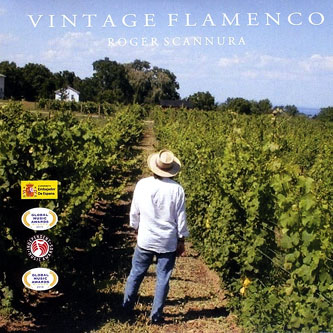 Born
on the island nation of Malta and living in Canada for most of his
adult life, Roger Scannura released Vintage Flamenco
in 2018. A worthy addition to his repertoire of critically
acclaimed albums, the nine track Vintage Flamenco features
all the virituosity that Roger brings to the world of 21st century
instrumental flamenco guitar. With nine tracks that clock in around
38 minutes, Vintage Flamenco is the optimum album to hear Roger’s
dazzling guitar technique and witness his craft for composing memorable
melodies and his overall scenic approach to flamenco. Key to Roger’s
inspiration is his family, including his wife Valerie Scannura
and his daughter Anjelica Scannura, who are collaborators with
Roger in their world-renowned Ritmo Flamenco Dance & Music Ensemble,
based in Toronto, where Roger also teaches guitar at York University.
Roger’s daughter Anjelica inspired the title of the Vintage
Flamenco track “Anjelica”, which features the only appearance
of Roger playing a passage on Fender Stratocaster, to make up for
a missing cellist who was supposed to play the part. Roger tells mwe3.com
"The
cellist did not show up for the recording session so there was a Fender
Stratocaster in the studio and I overdubbed and channeled some Carlos
Santana licks."
Roger
spent years perfecting his flamenco technique and he puts it all together
on Vintage Flamenco, which serves as a veritable instrumental
music tribute to his fondness of wine vintners and vineyards that
make infinite wine varieties. With many of the Vintage Flamenco
tracks composed and recorded and featuring titles of favorite
vineyards and the specific grapes that are then turned into wines,
it’s hard to select a favorite album track. In contrast to Roger’s
2009 album Noche Flamenca, which featured several guest artists,
including his wife Valerie, the 2018 CD release of Vintage
Flamenco spotlights Roger’s instrumental guitar and compositions
in a truly solo setting—enhanced only by his own occasional guitar
overdubs. Noting inflluences from the late great Paco de Lucia and
other flamenco guitar legends of the past, on Vintage Flamenco,
Roger Scannura brings the hard-earned grace and dynamic tension
of the flamenco guitar into a higher dimension. Vintage Flamenco
is a compelling and completely authentic expression of respect
of and devotion to the entire flamenco genre.
Born
on the island nation of Malta and living in Canada for most of his
adult life, Roger Scannura released Vintage Flamenco
in 2018. A worthy addition to his repertoire of critically
acclaimed albums, the nine track Vintage Flamenco features
all the virituosity that Roger brings to the world of 21st century
instrumental flamenco guitar. With nine tracks that clock in around
38 minutes, Vintage Flamenco is the optimum album to hear Roger’s
dazzling guitar technique and witness his craft for composing memorable
melodies and his overall scenic approach to flamenco. Key to Roger’s
inspiration is his family, including his wife Valerie Scannura
and his daughter Anjelica Scannura, who are collaborators with
Roger in their world-renowned Ritmo Flamenco Dance & Music Ensemble,
based in Toronto, where Roger also teaches guitar at York University.
Roger’s daughter Anjelica inspired the title of the Vintage
Flamenco track “Anjelica”, which features the only appearance
of Roger playing a passage on Fender Stratocaster, to make up for
a missing cellist who was supposed to play the part. Roger tells mwe3.com
"The
cellist did not show up for the recording session so there was a Fender
Stratocaster in the studio and I overdubbed and channeled some Carlos
Santana licks."
Roger
spent years perfecting his flamenco technique and he puts it all together
on Vintage Flamenco, which serves as a veritable instrumental
music tribute to his fondness of wine vintners and vineyards that
make infinite wine varieties. With many of the Vintage Flamenco
tracks composed and recorded and featuring titles of favorite
vineyards and the specific grapes that are then turned into wines,
it’s hard to select a favorite album track. In contrast to Roger’s
2009 album Noche Flamenca, which featured several guest artists,
including his wife Valerie, the 2018 CD release of Vintage
Flamenco spotlights Roger’s instrumental guitar and compositions
in a truly solo setting—enhanced only by his own occasional guitar
overdubs. Noting inflluences from the late great Paco de Lucia and
other flamenco guitar legends of the past, on Vintage Flamenco,
Roger Scannura brings the hard-earned grace and dynamic tension
of the flamenco guitar into a higher dimension. Vintage Flamenco
is a compelling and completely authentic expression of respect
of and devotion to the entire flamenco genre.
mwe3.com presents a new interview with
ROGER SCANNURA
The Vintage Flamenco Interview
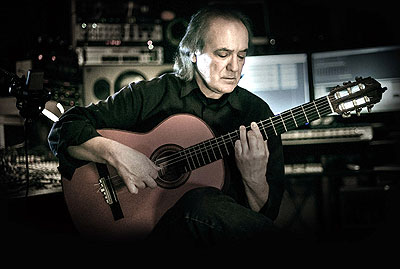 mwe3:
Your 2018 album Vintage Flamenco is your finest album yet.
Can you tell us where and when the music was written and recorded
and how you might compare it to your other recent albums? mwe3.com
featured your album Noche Flamenca way back in 2009, we clearly
have come catching up to do… What events led up to the making
of the Vintage Flamenco album and are there other players and
guitarists performing with you on the Vintage Flamenco album?
mwe3:
Your 2018 album Vintage Flamenco is your finest album yet.
Can you tell us where and when the music was written and recorded
and how you might compare it to your other recent albums? mwe3.com
featured your album Noche Flamenca way back in 2009, we clearly
have come catching up to do… What events led up to the making
of the Vintage Flamenco album and are there other players and
guitarists performing with you on the Vintage Flamenco album?
Roger Scannura: Vintage Flamenco is my way of sharing
the joy I feel touring vineyards. I spend my summers in Prince Edward
County in Canada, which is a growing and prospering wine region and
now consists of about thirty wineries. During the winter, I tour in
Spain and other wine regions such as the Sonoma Valley in California.
Vintage Flamenco is very listener friendly and although I focused
on beautiful melodies, I departed from my usual deep and dark flamenco
compositions. Since 2009, and I did release two other albums namely
Vida Flamenca, a very soulful CD of traditional guitar music,
as well as Sirocco, an album inspired by music of the Middle
East. I spent past winter composing and recording the music for Vintage
Flamenco and I am the only guitarist on it. I play two guitars
with overdubs or just solo.
mwe3: The world has undergone such drastic changes in the past
ten years. Are you still teaching guitar to students of Flamenco and
so how did your recording career and teaching career lead you to become
involved in the vineyards and wine world?
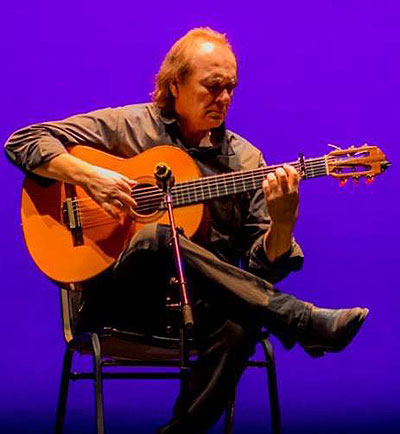 Roger
Scannura: I feel the world in general is going through some turbulent
times as every day we hear about sad events both political well as
natural occurrences. I wanted to provide a bit of joy with this album…
like a summer day sipping wine with friends and family away from the
trails of everyday life. I enjoy teaching, both at York University
where I am a course director and in private instruction with a dedicated
group of students both in Canada and Spain. In a way, teaching flamenco
is like a gospel that I need to spread and I love inspiring people
of all ages and backgrounds to learn to love the art form as much
as I do. Sometimes teaching takes a back seat to performing when I
am concentrating on composing material for live concerts, recordings
and painting.
Roger
Scannura: I feel the world in general is going through some turbulent
times as every day we hear about sad events both political well as
natural occurrences. I wanted to provide a bit of joy with this album…
like a summer day sipping wine with friends and family away from the
trails of everyday life. I enjoy teaching, both at York University
where I am a course director and in private instruction with a dedicated
group of students both in Canada and Spain. In a way, teaching flamenco
is like a gospel that I need to spread and I love inspiring people
of all ages and backgrounds to learn to love the art form as much
as I do. Sometimes teaching takes a back seat to performing when I
am concentrating on composing material for live concerts, recordings
and painting.
mwe3: You say you own some land and also are involved in growing
grapes for wine production, do you have your own brand of wine yet?
Roger Scannura: Initially, I made my own wine but it is a difficult
process. I watch my winemaker friends worry about so many things beyond
their control and their lives are completely focused on their production
every year. So I’d rather focus on my music. Part of my rider
at my winery concerts is a bottomless glass of wine from my generous
vintner friends!
mwe3: What vineyards in Canada and Spain are you interested
in?
Roger Scannura: In Canada, I have performed at numerous wineries
in the Niagara region but I love the area I live in called Prince
Edward County. The county is known as a relatively newer wine growing
area and is home to over 30 wineries that use the rich terroir to
produce scores of award-winning wines. Over the years I have developed
key relationships with many great wine makers and each summer I have
lived in the county my music has been appreciated and loved so I am
now performing every weekend in intimate concert settings or in traditional
flamenco settings with my wife, Valerie dancing flamenco. I have a
few favorites like Traynor Family Vineyard, which is practically my
backyard, Three Dog Winery, Terracello and Del Gatto Estates. They
are small ‘ma and pa’ family owned wineries friendly and
welcoming and they inspire me with their enthusiasm for wine and wine
making.
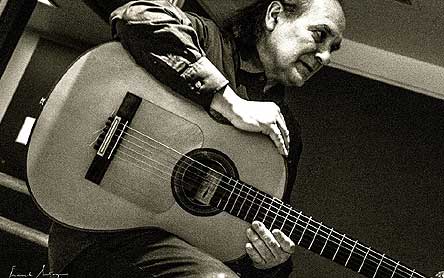 mwe3:
Tell us about your recent tours in both Canada and Spain. Be great
to see you perform a concert in Miami where there is a large Latin
community and musical audience. Is a concert in the US out of the
question?
mwe3:
Tell us about your recent tours in both Canada and Spain. Be great
to see you perform a concert in Miami where there is a large Latin
community and musical audience. Is a concert in the US out of the
question?
Roger
Scannura: In Spain, I tour Jerez de la Frontera and in 2019 we
have plans to tour Rioja, Almansa, Alicante, Navarra and La Mancha.
I only have a couple of dates in the U.S. at the moment. We will be
at the Finger Lakes and Hamburg N.Y. in the fall of 2018. I have many
friends and fans in Miami and would love to perform there.
mwe3: Tell us about Ritmo Flamenco and the School Of Ritmo
Flamenco. When did you start the school, what do you teach there and
who else is involved in the school? Can you tell the readers about
your wife Valerie and her importance in the Ritmo Flamenco school?
Roger Scannura: When I met my wife Valerie in the early 1980’s
she was just learning flamenco dance at a school based in Toronto.
I was accompanying the classes and we ended up being sent to do shows
together. Our relationship became serious right away and at that point
we realized we could start our own school and dance company together.
Ritmo Flamenco was formed in 1995 as both a school of flamenco music
and dance and a professional dance company with an ensemble of dancers
and musicians that we have trained. Valerie has a strong background
in ballet as she studied professionally at the National Ballet School
and graduated to teach ballet. She has an ability to understand the
underlying techniques of dance and she developed a method of teaching
flamenco based on our trips to Spain together, which we also took
together throughout the 1990’s. Our relationship as husband and
wife allowed us to build the school and company together and we have
enjoyed the process of teaching together. I would accompany many of
the classes, which allowed us to understand and craft the art form
in an authentic way, much as they do in the studios in Spain. Many
great flamenco artists have strong relationships and are usually family
members who live, teach and perform together.
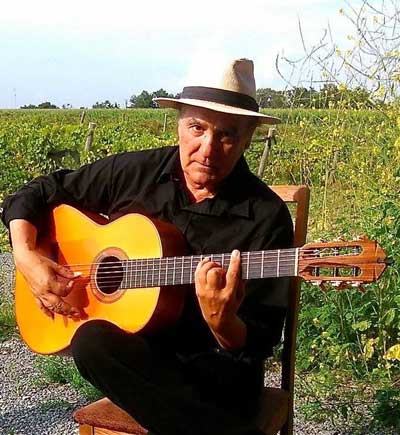 mwe3:
Your daughter Anjelica is also an important part of Ritmo. Plus, I
saw you just performed a show for the Fiesta De Verano.
mwe3:
Your daughter Anjelica is also an important part of Ritmo. Plus, I
saw you just performed a show for the Fiesta De Verano.
Roger Scannura: The birth of our daughter Anjelica in 1989
inspired us even further as she became a beautifully talented dancer
who has won prestigious awards and is a critically acclaimed choreographer.
She also is now co-artistic director of the dance company and as a
trio, we have been invited to perform in concerts and festivals in
Canada, the US, Europe and the Middle East. One of our concert highlights
was being invited to perform in Amman, Jordan at the ancient Roman
Theatre for over 1,500 people. The performance “Fiesta de Verano”
was our year-end performance featuring the talented students of our
school.
mwe3: There are a variety of parts involved in the art of Flamenco,
from the music to the guitar techniques to the dancing and even special
costumes. How would you describe what you do with Ritmo?
Roger Scannura: Each year, we train dancers and musicians to
prepare them for professional theatrical performances. This year our
22nd performance and we were thrilled to be able to produce these
types of events! Flamenco takes a lifetime to learn and there are
many layers to understanding the techniques necessary to becoming
an adept player or dancer. In 2011, UNESCO declared flamenco as a
World Heritage Treasure. This is extremely important as now Spain
and the world can aim to preserve and protect it as a cultural form
and continue to expand its diversity due to globalization.
When we go to Spain to take students to train in areas like Madrid
or Jerez, we see so many students from all countries of the world
embracing the art form and trying to learn it from the source. We
research the latest innovations in terms of see what costumes, castanets,
flamenco shoes, and guitars are being used and stay on trend with
these items and order them for our students. From this accumulation
of knowledge, we take what we can from it but are flexible in our
approach to new students interested in learning flamenco. We want
to instill the fun and vibrancy as well as respect for such an ancient
art form. It takes diligence and perseverance to teach this way but
the rewards are worth it!
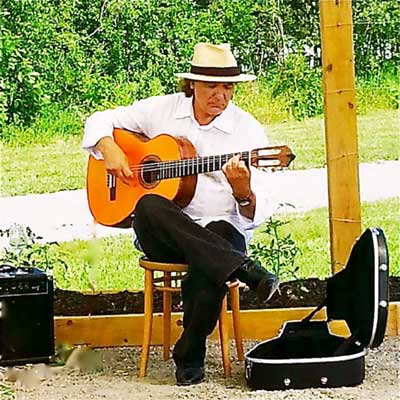 mwe3:
Your background is in classical guitar and you have said that your
aunt urged you to become interested in Flamenco and Gypsy music.
mwe3:
Your background is in classical guitar and you have said that your
aunt urged you to become interested in Flamenco and Gypsy music.
Roger Scannura: I loved the freedom and passion of flamenco
compared to classical guitar. The study of classical guitar is quite
solitary but in flamenco you get to work with dancers and singers.
The technique of playing classical is very structured while playing
flamenco requires strength, agility and emotion. My wife Valerie is
an incredible dancer, choreographer and teacher. She also has musical
gifts; she plays piano and has perfect pitch! Our daughter Anjelica
is a superstar. She has performed with us all over the world since
the age if six. She has studied many forms of dance: ballet, contemporary,
Irish, belly dance and flamenco! She is also an award- winning choreographer
and has danced and competed in Spain on major stages. She is also
an accomplished actress with a few films under her belt. This summer
she is in a film called Little Italy with Hayden Christensen
(Star Wars) and Emma Roberts, who is Julia Roberts’ niece.
mwe3: How did spending time in Spain and studying guitar there
affect your interest in music and the guitar and what impact did your
teacher Pepe Habichuela have on your guitar sound?
Roger Scannura: Studying with Pepe was quite an experience
as I tracked him down at his home in Granada. I still remember him
opening the door and allowing me to come in. However, he kept me waiting
awhile because I arrived early. He took a short nap then the lesson
began. I’ll never forget that day. He just treated me like an
old friend, offering copas and stories but he instilled in me the
importance of strong compás (rhythm) that is the heartbeat
of flamenco. Flamenco has over 60 complex rhythms with specific rules
and Pepe is the master of all those. We spent 12 years working on
nothing but these rhythms.
 mwe3:
Do you still travel to Malta and Spain?
mwe3:
Do you still travel to Malta and Spain?
Roger Scannura: I have not been able to go to Malta for quite
a few years but the last time we were there, we performed in the silent
city called Mdina and the concert was attended by a huge audience
and among them was the Prime Minister of Malta. Right now my schedule
has been very busy but I do hope to get there after the Spain tour
in 2019. I regularly perform frequently for the Maltese community
in Canada and one of the songs on Vintage flamenco called “Mediterra”
is now the theme music on the Maltese TV program “Lehen Malti”
which is broadcast on North America twice a week.
mwe3: You mention Pace de Lucia as your biggest influence.
How would you contrast Paco’s influence with your other guitar
influences, from the classical masters to even rock guitarists? You
also mentioned Vincente Amigo and Manolo Sanlucar, who are both still
alive.
Roger Scannura: Paco de Lucia was the main innovator of flamenco
guitar. All other guitarists who followed were influenced and inspired
by him including Vicente Amigo and Manolo Sanlucar. Paco took flamenco
guitar into a whole new realm incorporating jazz and afro-cuban influences.
He was the first flamenco guitarist to work with the likes of Chick
Corea, Miles Davis and Carlos Santana, to name a few.
mwe3: Getting back to Vintage Flamenco, are all the
tracks inspired by vineyards? For example, the leadoff track “Babylon”
is very traditional Flamenco. Why did you call the track “Babylon”
and what is the significance of the title?
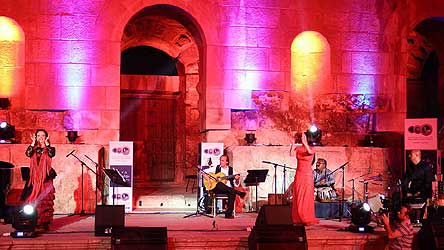 Roger
Scannura: I called the track “Babylon” because I used
chord progressions and scales from Arabic music. I wanted to capture
the boldness of Syrah wine, which originated in the Middle East centuries
ago.
Roger
Scannura: I called the track “Babylon” because I used
chord progressions and scales from Arabic music. I wanted to capture
the boldness of Syrah wine, which originated in the Middle East centuries
ago.
mwe3: Is “Medittera” inspired by Mediterranean area?
How many guitars are you playing on that track? How difficult is it
to overdub guitars on certain tracks, especially as the rhythms are
so intense?
Roger Scannura: “Meditterra” is inspired by guitar
and folk music of Sicily and Malta. I am playing two guitars. I like
overdubbing because I prefer my own way of playing rhythm and constructing
melody so the final result is exactly what I envisioned.
mwe3: “Vin de Verano” is one of your best melodies.
I love the lighthearted approach to that track. Did you set out to
write a song that was very airy and melodic? Is it another wine vineyards
tribute song?
Roger Scannura: “Vin de Verano” is basically inspired
by fresh summer wine that is light and airy and chilled to perfection.
I have let audiences listen to the song and let them guess which wine
it was inspired by and unanimously the answer is always “Summerwine”.
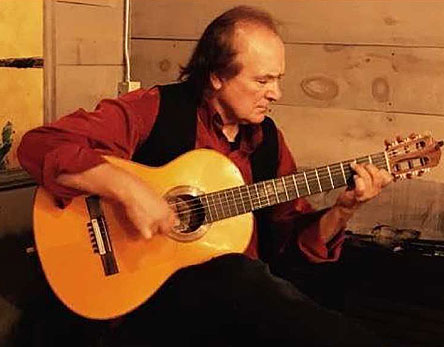 mwe3:
Is “Anjelica” a tribute to your daughter? That track is
also the longest track on Vintage Flamenco and it features
very stately melody and also electric guitar as well. What electric
guitars are you playing on that track and which strings do you prefer?
mwe3:
Is “Anjelica” a tribute to your daughter? That track is
also the longest track on Vintage Flamenco and it features
very stately melody and also electric guitar as well. What electric
guitars are you playing on that track and which strings do you prefer?
Roger Scannura: Yes, the track “Anjelica” is for
my daughter. When I recorded it, I had meant for a cellist to come
in and the end of the song. The cellist did not show up for the recording
session so there was a Fender Stratocaster in the studio and I overdubbed
and channeled some Carlos Santana licks.
mwe3: What guitars are you playing on Vintage Flamenco and
what strings do you prefer? How about your practice schedule? To keep
up your well-honed technique, are there studies you play like the
Sor Studies, which Segovia made famous. Also I believe John Williams
20 Sor Studies album is another big classic guitar influence.
Roger Scannura: On all the tracks I use my 1973 Conde Flamenco
Negra, which previously owned by Paco de Lucia and gifted to me. I
prefer Conde high tension flamenco strings. I practice about an hour
every morning and an hour at night plus playing for 3 hours of dance
classes daily. I have worked on the Segovia scales but as this point
I have a huge repertoire and I simply warm up by playing repertoire
at half the speed. I also like to use Bach’s lute pieces as technique
exercises.
mwe3: Is the track “Rondena” about something specific?
Would you say, “Rondena” has a more traditional Flamenco
sound to it? What inspired “Rondena”?
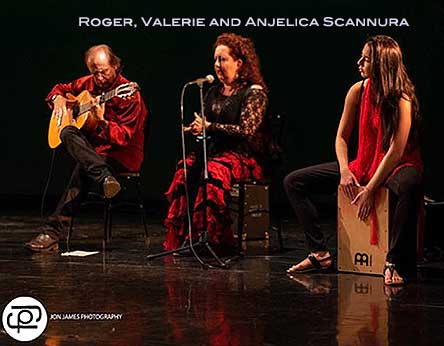 Roger
Scannura: “Rondena” is inspired by the town of Ronda
in southern Spain. It’s one of the few palos that is in alternate
tuning and creates a very haunting and droning sound. The vines in
Ronda where planted by the Romans hundreds of years ago and this piece
is an homage to the bold, red Spanish wine.
Roger
Scannura: “Rondena” is inspired by the town of Ronda
in southern Spain. It’s one of the few palos that is in alternate
tuning and creates a very haunting and droning sound. The vines in
Ronda where planted by the Romans hundreds of years ago and this piece
is an homage to the bold, red Spanish wine.
mwe3: Track six “Chardonnay” is a tribute to the
type of wine? What is Chardonnay in your opinion and is that the most
popular or best-known type of white wine? What do you look for in
a good chardonnay wine and how does the music reflect the title?
Roger Scannura: I wrote this while I was in the Sonoma valley
a couple of years ago. I never used to like chardonnay, you know when
most people are asked what wine do they like the response is usually
ABC. Anything But Chardonnay. I made a lot of friends and had many
great conversations in Sonoma over a bottle of 'Chard'. I therefore
dedicate this piece to those friends who provided me with many great
memories and instilled in me a love for Chardonnay…
mwe3: “Malbec” is dedicated to the purple grapes
used in red wine? I heard they even grow the Malbec on Long Island
in New York and there’s even a Malbec World Day to celebrate
the Malbec wine.
Roger Scannura: I titled the piece “Malbec” because
the grape originates from Argentina. I used folk melodies from the
“gauchos” of the pampas. I try to create a song with deep
Argentinean roots within a flamenco framework.
mwe3: Track eight “Tempranillo” celebrates the black
grape used to make red wines in Spain. What’s your opinion on
Tempranillo wines? The track has a ferocious energy on the closing.
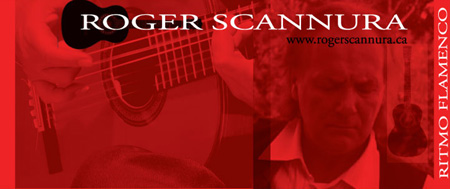 Roger
Scannura: “Tempranillo” is my favorite wine and it is
referred to in Spain as “Sangre del Toro” or “Bull’s
Blood”.
Roger
Scannura: “Tempranillo” is my favorite wine and it is
referred to in Spain as “Sangre del Toro” or “Bull’s
Blood”.
mwe3: “Vuelo” is a great way to close out Vintage
Flamenco yet it’s very minor key in sound. Is “Vuelo”
a wine related term? What inspired the track?
Roger Scannura: “Vuelo” translates into “flight”.
I enjoy listening to Ralph Vaughan Williams especially his piece “The
Lark Ascending”. Musically the piece is inspired by this British
impressionist composer. When one goes for a wine tasting, and will
sample several wines, it is referred to as a “flight”.
mwe3: With the release of Vintage Flamenco what are
you plans for 2018 and even next year? Are you planning new writing,
recording, live concerts? Are you planning a possible retrospective
or DVD to further bring your name to further prominence in the ever-popular
Flamenco and guitar world?
 Roger
Scannura: My plans are to tour more vineyards in Europe and possibly
the U.S.A. promoting Vintage Flamenco. A double CD anthology
is in the works for late 2019. It will contain some of my favorites
from my discography plus a few new compositions.
Roger
Scannura: My plans are to tour more vineyards in Europe and possibly
the U.S.A. promoting Vintage Flamenco. A double CD anthology
is in the works for late 2019. It will contain some of my favorites
from my discography plus a few new compositions.



